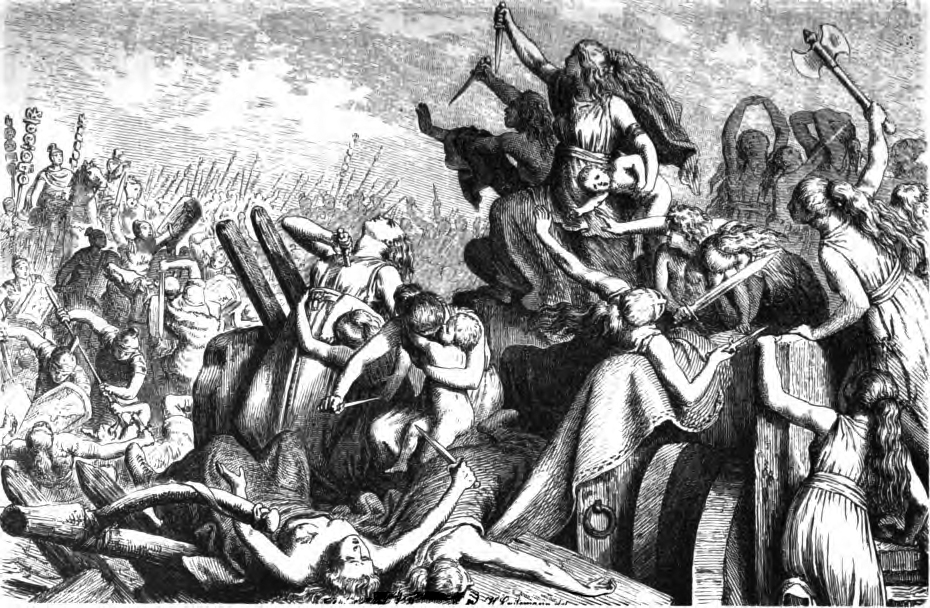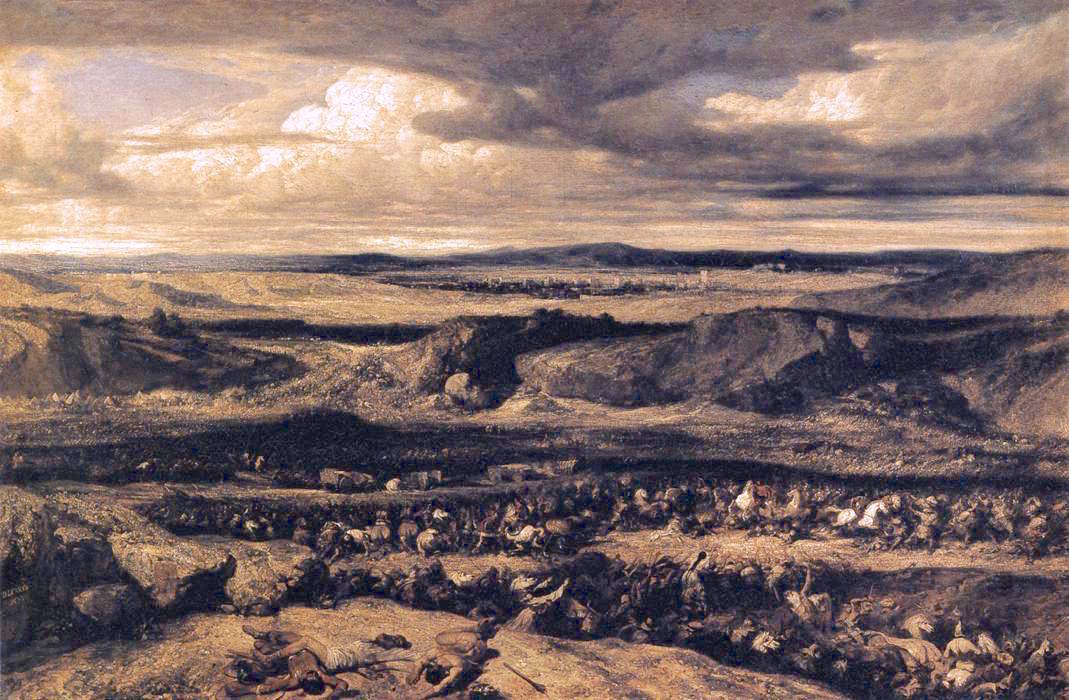|
Arausio
Orange (; Provençal: ''Aurenja'' or ''Aurenjo'' ) is a commune in the Vaucluse department in the Provence-Alpes-Côte d'Azur region in southeastern France. It is about north of Avignon, on the departmental border with Gard, which follows the Rhône. Orange is the second-most populated city in Vaucluse, after Avignon. Name The settlement is attested as ''Arausio'' and ''Arausion'' in the first and second centuries AD, then as '' civitas Arausione'' in the fourth century, ''civitas Arausicae'' in 517 (via a Germanized form *''Arausinga''), ''Aurengia civitatis'' in 1136, and as ''Orenga'' in 1205. The name ''Arausio'' can be explained as the Gaulish ''ar-aus(i)o''- ('temple, cheek'), itself derived from an earlier Proto-Celtic *''far-aws(y)o''-, which literally means 'in front of the ear' (cf. Old Irish ''ara'', ''arae''; Ancient Greek ''pareiaí'', ''parauai'' < *''par-ausiā''). It is |
Battle Of Arausio
The Battle of Arausio took place on 6 October 105 BC, at a site between the town of Arausio (now Orange, Vaucluse), and the Rhône River. Ranged against the migratory tribes of the Cimbri under Boiorix and the Teutoni under Teutobod were two Roman armies, commanded by the proconsul Quintus Servilius Caepio and consul Gnaeus Mallius Maximus. However, bitter differences between the commanders prevented the Roman armies from co-operating, with devastating results. The terrible defeat gave Gaius Marius the opportunity to come to the fore and make radical reforms to the organisation and the recruitment of Roman legions. Roman losses are described as being up to 80,000 troops as well as another 40,000 auxiliary troops ( allies) and servants and camp followers – 120,000 in total, virtually all of their participants in the battle. In terms of losses, the battle is regarded as one of the worst defeats in the history of ancient Rome. Even surpasssing the devastating Battle of Cann ... [...More Info...] [...Related Items...] OR: [Wikipedia] [Google] [Baidu] |
Arausio (god)
Arausio was a local Celtic water god who gave his name to the town of Arausio (Orange) in southern Gaul, as attested to by ancient inscriptions. The modern name of both the city and the family that established itself there, the House of Orange-Nassau, is a corrupted version of the Celtic word Arausio. In the Middle Ages, the name of the city was conflated in French and Late Latin with another word, orange Orange most often refers to: *Orange (fruit), the fruit of the tree species '' Citrus'' × ''sinensis'' ** Orange blossom, its fragrant flower *Orange (colour), from the color of an orange, occurs between red and yellow in the visible spectrum * .... References {{DEFAULTSORT:Arausio (God) Gaulish gods Sea and river gods Orange, Vaucluse ... [...More Info...] [...Related Items...] OR: [Wikipedia] [Google] [Baidu] |
Teutones
The Teutons ( la, Teutones, , grc, Τεύτονες) were an ancient northern European tribe mentioned by Roman authors. The Teutons are best known for their participation, together with the Cimbri and other groups, in the Cimbrian War with the Roman Republic in the late second century BC. Julius Caesar described them as a Germanic people, a term he applied to all northern peoples located east of the Rhine, and later Roman authors followed him. On one hand, there is no direct evidence that they spoke a Germanic language, and evidence such as their name, and the names of their rulers, indicates at least a strong influence from Celtic languages. On the other hand the indications that classical authors gave about the homeland of the Teutones is considered by many scholars to show that they lived in an area associated with early Germanic languages, and not Celtic languages. Name The ethnonym is attested in Latin as ''Teutonēs'' or ''Teutoni'' (plural) or, more rarely, as ''Teut ... [...More Info...] [...Related Items...] OR: [Wikipedia] [Google] [Baidu] |
Cimbri
The Cimbri (Greek Κίμβροι, ''Kímbroi''; Latin ''Cimbri'') were an ancient tribe in Europe. Ancient authors described them variously as a Celtic people (or Gaulish), Germanic people, or even Cimmerian. Several ancient sources indicate that they lived in Jutland, which in some classical texts was called the Cimbrian peninsula. There is no direct evidence for the language they spoke, though some scholars argue that it must have been a Germanic language, while others argue that it must have been Celtic. Together with the Teutones and the Ambrones, they fought the Roman Republic between 113 and 101 BC during the Cimbrian War. The Cimbri were initially successful, particularly at the Battle of Arausio, in which a large Roman army was routed. They then raided large areas in Gaul and Hispania. In 101 BC, during an attempted invasion of the Italian peninsula, the Cimbri were decisively defeated at the Battle of Vercellae by Gaius Marius, and their king, Boiorix, was killed. So ... [...More Info...] [...Related Items...] OR: [Wikipedia] [Google] [Baidu] |
Orange (word)
The word ''orange'' is a noun and an adjective in the English language. In both cases, it refers primarily to the orange fruit and the color orange, but has many other derivative meanings. The word is derived from a Dravidian language, and it passed through numerous other languages including Sanskrit and Old French before reaching the English language. The earliest uses of the word in English refer to the fruit, and the color was later named after the fruit. Before the English-speaking world was exposed to the fruit, the color was referred to as "yellow-red" ('' geoluread'' in Old English) or "red-yellow". "Orange" has no true rhyme. There are several half rhymes or near-rhymes, as well as some proper nouns and compound words or phrases that rhyme with it. This lack of rhymes has inspired many humorous poems and songs. Etymology The word "orange" entered Middle English from Old French and Anglo-Norman ''orenge''. The earliest recorded use of the word in English is from th ... [...More Info...] [...Related Items...] OR: [Wikipedia] [Google] [Baidu] |
Proto-Celtic
Proto-Celtic, or Common Celtic, is the ancestral proto-language of all known Celtic languages, and a descendant of Proto-Indo-European. It is not attested in writing but has been partly Linguistic reconstruction, reconstructed through the comparative method. Proto-Celtic is generally thought to have been spoken between 1300 and 800 BC, after which it began to split into different languages. Proto-Celtic is often associated with the Urnfield culture and particularly with the Hallstatt culture. Celtic languages share common features with Italic languages that are not found in other branches of Indo-European, suggesting the possibility of an earlier Italo-Celtic linguistic unity. Proto-Celtic is currently being reconstructed through the comparative method by relying on later Celtic languages. Though Continental Celtic presents much substantiation for Proto-Celtic phonology, and some for its morphology (linguistics), morphology, recorded material is too scanty to allow a secure rec ... [...More Info...] [...Related Items...] OR: [Wikipedia] [Google] [Baidu] |
Roman Republic
The Roman Republic ( la, Res publica Romana ) was a form of government of Rome and the era of the classical Roman civilization when it was run through public representation of the Roman people. Beginning with the overthrow of the Roman Kingdom (traditionally dated to 509 BC) and ending in 27 BC with the establishment of the Roman Empire, Rome's control rapidly expanded during this period—from the city's immediate surroundings to hegemony over the entire Mediterranean world. Roman society under the Republic was primarily a cultural mix of Latin and Etruscan societies, as well as of Sabine, Oscan, and Greek cultural elements, which is especially visible in the Roman Pantheon. Its political organization developed, at around the same time as direct democracy in Ancient Greece, with collective and annual magistracies, overseen by a senate. The top magistrates were the two consuls, who had an extensive range of executive, legislative, judicial, military, and religious powers ... [...More Info...] [...Related Items...] OR: [Wikipedia] [Google] [Baidu] |
Orange (fruit)
An orange is a fruit of various citrus species in the family (biology), family Rutaceae (see list of plants known as orange); it primarily refers to Citrus × sinensis, ''Citrus'' × ''sinensis'', which is also called sweet orange, to distinguish it from the related ''Citrus × aurantium'', referred to as bitter orange. The sweet orange reproduces asexually (apomixis through nucellar embryony); varieties of sweet orange arise through mutations. The orange is a Hybrid (biology), hybrid between pomelo (''Citrus maxima'') and Mandarin orange, mandarin (''Citrus reticulata''). The chloroplast genome, and therefore the maternal line, is that of pomelo. The sweet orange has had its full Whole genome sequencing, genome sequenced. The orange originated in a region encompassing Southern China, Northeast India, and Myanmar, and the earliest mention of the sweet orange was in Chinese literature in 314 BC. , orange trees were found to be the most Tillage, cultivated fruit tree in the wo ... [...More Info...] [...Related Items...] OR: [Wikipedia] [Google] [Baidu] |
Julian (Rome)
The gens Julia (''gēns Iūlia'', ) was one of the most prominent patrician families in ancient Rome. Members of the gens attained the highest dignities of the state in the earliest times of the Republic. The first of the family to obtain the consulship was Gaius Julius Iulus in 489 BC. The gens is perhaps best known, however, for Gaius Julius Caesar, the dictator and grand uncle of the emperor Augustus, through whom the name was passed to the so-called Julio-Claudian dynasty of the first century AD. The Julius became very common in imperial times, as the descendants of persons enrolled as citizens under the early emperors began to make their mark in history.''Dictionary of Greek and Roman Biography and Mythology'', vol. II, pp. 642, 643. Origin The Julii were of Alban origin, mentioned as one of the leading Alban houses, which Tullus Hostilius removed to Rome upon the destruction of Alba Longa. The Julii also existed at an early period at Bovillae, evidenced by a v ... [...More Info...] [...Related Items...] OR: [Wikipedia] [Google] [Baidu] |
Celts
The Celts (, see pronunciation for different usages) or Celtic peoples () are. "CELTS location: Greater Europe time period: Second millennium B.C.E. to present ancestry: Celtic a collection of Indo-European peoples. "The Celts, an ancient Indo-European people, reached the apogee of their influence and territorial expansion during the 4th century bc, extending across the length of Europe from Britain to Asia Minor."; . " e Celts, were Indo-Europeans, a fact that explains a certain compatibility between Celtic, Roman, and Germanic mythology."; . "The Celts and Germans were two Indo-European groups whose civilizations had some common characteristics."; . "Celts and Germans were of course derived from the same Indo-European stock."; . "Celt, also spelled Kelt, Latin Celta, plural Celtae, a member of an early Indo-European people who from the 2nd millennium bce to the 1st century bce spread over much of Europe."; in Europe and Anatolia, identified by their use of Celtic langua ... [...More Info...] [...Related Items...] OR: [Wikipedia] [Google] [Baidu] |
Legio II Augusta
Legio II Augusta ( Second Legion "Augustus'") was a legion of the Imperial Roman army that was founded during the late Roman republic. Its emblems were the Capricornus, Pegasus, and Mars. It may have taken the name "''Augusta''" from a victory or reorganization that occurred during the reign of Augustus. In Republican service The Legio II, Sabina was a Roman military unit of the late Republican era, which may have been formed by Julius Caesar in the year of the consulate of 48 BC and coincide, in this case, with the Legio II. Enlisted to fight against Pompey, they took part in the subsequent Battle of Munda of 45 BC. Alternatively it could be the Legio II, formed by the consul, Gaius Vibius Pansa in 43 BC and recruited in Sabina, hence its nickname. If this theory is true, then it probably participated in the subsequent battle of Philippi of 42 BC on the side of the triumvirate, Octavian and Marc Antony. After the defeat of the Republicans, Legio II swore allegiance to Octavia ... [...More Info...] [...Related Items...] OR: [Wikipedia] [Google] [Baidu] |
Alpes-de-Haute-Provence
Alpes-de-Haute-Provence or sometimes abbreviated as AHP (; oc, Aups d'Auta Provença; ) is a department in the Provence-Alpes-Côte d'Azur region of France, bordering Alpes-Maritimes and Italy to the east, Var to the south, Vaucluse to the west, Drôme and Hautes-Alpes to the north. Formerly part of the province of Provence, it had a population of 164,308 in 2019,Populations légales 2019: 04 Alpes-de-Haute-Provence INSEE which makes it the 94th most populated French department. Alpes-de-Haute-Provence's main cities are |






.jpg)
